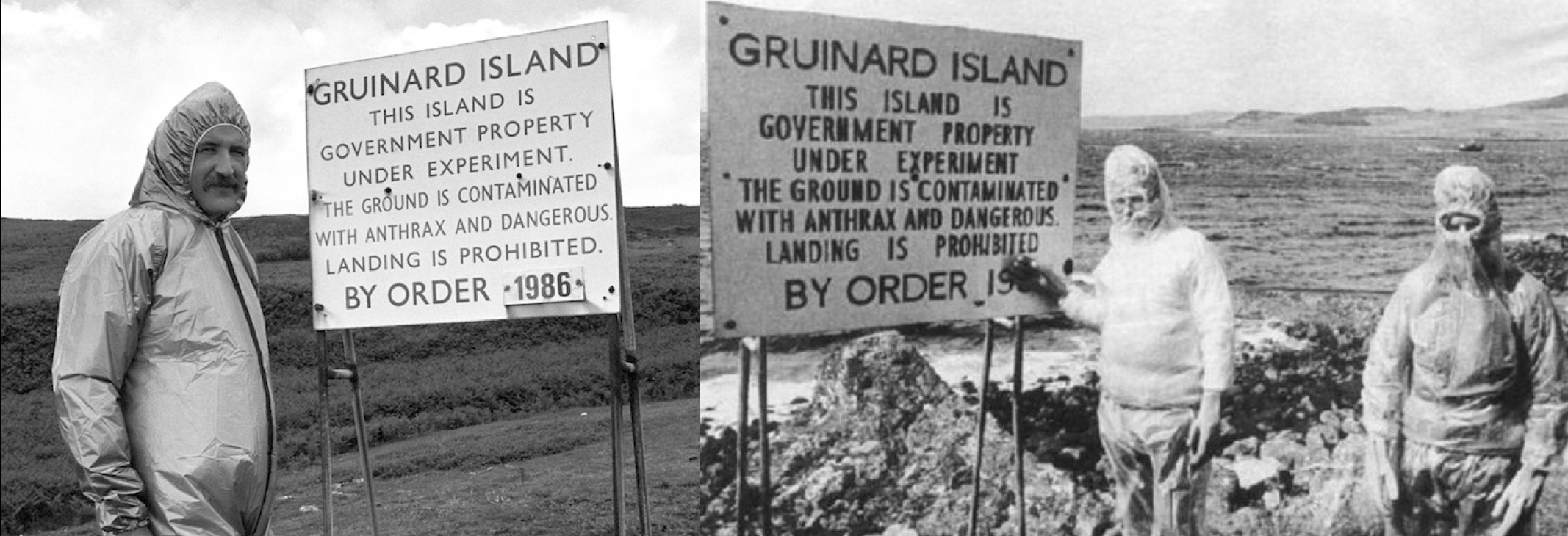
In a remote part of Scotland’s Inner Hebrides there’s an island, but it’s not much to look at.
Just over a mile long and half a mile wide, windswept, the place lies lifeless; ‘dozens of rabbit holes but no rabbits’, remarked visiting journalist David Harrison back in 2001. Originally ‘full of woods’ and a ‘guid for fostering of thieves and rebellis’, as described by 16th century clergyman Dean Munro, no one quite knows when Gruinard Island was finally abandoned, although it was probably sometime in 1920s.
But whilst the remains of the last residents’ cottages and field stone walls have always been visible to the naked eye, the island’s invisible threat has not: an indiscriminate killer that rendered this place uninhabitable for the best part of forty years.
In 1942, the War Department identified Gruinard Island as a site for urgent field trials on biological warfare. At that time there was an investigation by the British government into the feasibility of an attack using anthrax, an incredibly fast-acting and lethal disease caused by the bacterium Bacillus anthracis. Given the killer nature of the biological weapon which was being developed, it was quickly recognised that tests would have to be conducted in a remote and totally uninhabited island. Gruinard was surveyed, deemed suitable and requisitioned from its owners for use by Her Majesty’s Government.
The anthrax strain chosen for the Gruinard bioweapons trials was a highly virulent type called ‘Vollum 14578’, named after R. L. Vollum, Professor of Bacteriology at the University of Oxford, who supplied it. Some 80 sheep were unfortunate enough to be selected as the species-appropriate sacrificial lambs and taken to the island; bombs filled with anthrax spores were exploded close to where selected groups were tethered. The animals became infected with anthrax.
The results of this sad spate of animal testing were record on a 16mm colour movie film, which was only declassified in 1997, one sequence showing the detonation of an anthrax bomb fixed at the end of a tall pole supported with guy ropes. When the bomb is detonated a brownish aerosol cloud drifts away towards the target animals. A later sequence shows anthrax-infected sheep carcasses being burned in incinerators following the conclusion of the experiment.
The war ended with no chemical weapons thankfully ever being deployed in anger (with the exception of Japan’s highly secret and mass war-crime-committing Unit 731 operating in mainland China) but the government had a new problem on their hands: anthrax spores can survive in soil for hundred of years. Gruinard was now polluted with a terrifying bio-toxin, potentially lethal to all who might set foot there.
What’s worse, the land was judged too hazardous and expensive to decontaminate sufficiently to allow public access. The island, never a popular destination to begin with, was shuttered, quarantined indefinitely. All visits were prohibited, except periodic checks by government scientists to determine the level of contamination. Yet, even thirty five years later, the complete closure of the island proved insufficient to completely halt the anthrax-threat.

In 1981, newspapers began receiving messages with the heading ‘Operation Dark Harvest’, a militant group loosely affiliated to independence-seeking Scottish nationalists, which demanded that the government decontaminate the island. The group threatened to leave samples of the soil ‘at appropriate points that will ensure the rapid loss of indifference of the government and the equally rapid education of the general public’.
On the same day as the threat a sealed package of soil was left outside the military research facility at Porton Down; tests revealed that it contained anthrax bacilli. A few days later another sealed package of soil was left in Blackpool, where the ruling Conservative Party was holding its annual conference. The soil did not contain anthrax, but officials said that the earth was similar in composition to that found on the island.
It wasn’t until in 1986, that a determined effort was made for decontamination. Over 280 tonnes of formaldehyde solution diluted in seawater were pumped over all 196 hectares of the island and the worst-contaminated topsoil around the dispersal site being removed.
A flock of sheep, again the ever-suffering bearers of our experimental urges, were placed on Gruinard and, thankfully, this time remained perfectly healthy. On 24 April 1990, after 48 years of quarantine and four years after the solution being applied, junior defence minister Michael Neubert visited the island and announced its safety by removing the warning signs. On 1 May 1990, the island was repurchased by the heirs of the original owner for the original sale price of £500.
These days the place is considered safe for humans to visit. Yet, even now, tourist guides still remind visitors to the Highlands about the site’s notorious past, and it seems unlikely that Gruinard Island will ever shake the stain of its bio-toxic past.
What do you think, would you make a visit?
